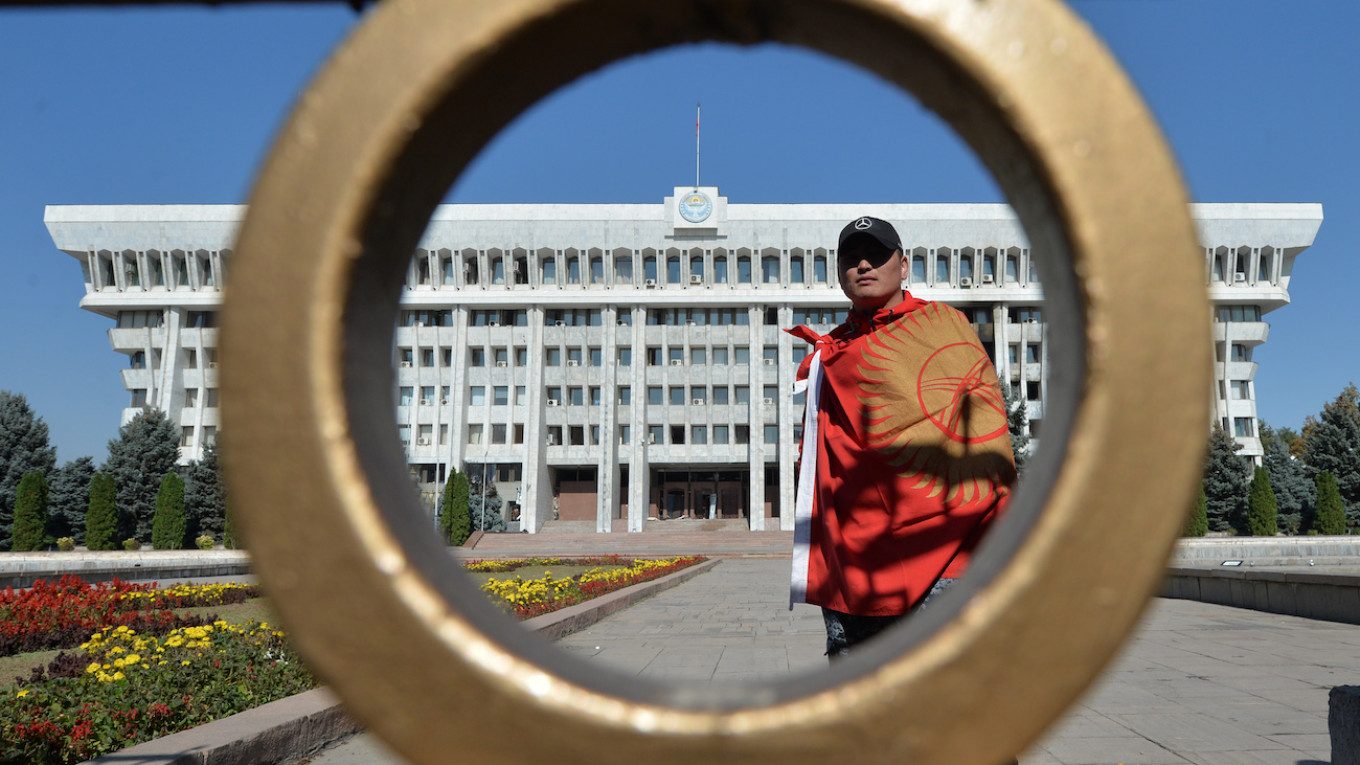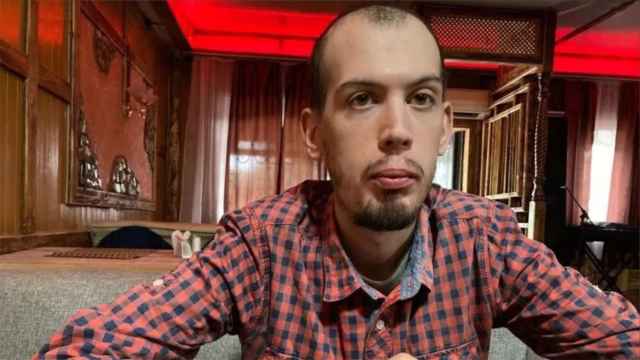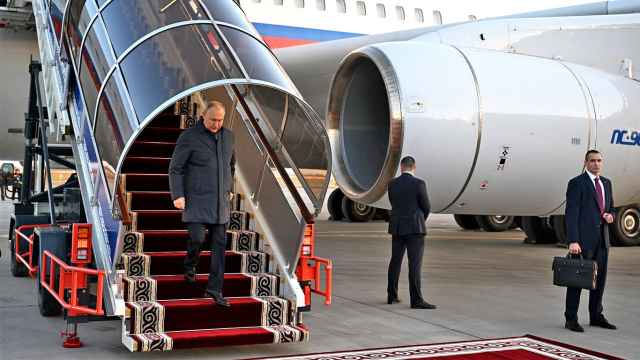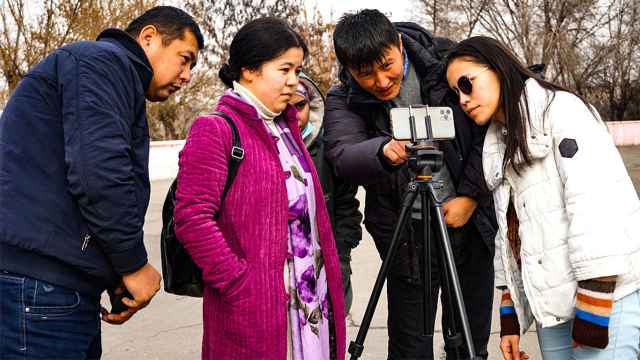Kyrgyzstan is seeing its biggest protests in a decade, which could become the prologue to the third revolution there in fifteen years. In just one night, President Sooronbay Jeenbekov lost much of his authority, though formally he retains his position. Meanwhile, his bitter enemy, former president Almazbek Atambayev, is out of prison and back in the game, as are many other players. Behind the current chaos and endless power grabs runs the central nerve of Kyrgyz politics in recent years: the battle for power between regional groupings masquerading as political parties.
Thousands of people took to the streets of the capital Bishkek on October 5 to protest the results of the parliamentary elections and demand new elections. That night, protesters seized Bishkek’s White House, home to both the Kyrgyz parliament and the presidential administration. The crowd then went on to the National Security Committee building and freed ex-president Atambayev and other high-ranking former officials from a jail inside.
Jeenbekov, who has been president of Kyrgyzstan since 2017, is now in an unknown location. The day after he effectively lost his grip on the country, the electoral commission annulled the results of the vote, but protests against a wide range of problems, from electoral fraud to local corruption, continue to take place in many cities.
In the meantime, politicians, former and current officials, security service officers, businessmen, and crime bosses are garnering supporters and holding talks with one another on future alliances. Power in Kyrgyzstan, which underwent revolutions in both 2005 and 2010, has shattered into a multitude of pieces.
The recent elections had been greatly anticipated, since people’s trust in the last parliament was very low. Of the sixteen parties that ran in the election on October, 4, only four were announced to have won seats in parliament, all of which represent the interests of groups that could be described as southern. One of them is controlled by President Jeenbekov’s brother, and another by the influential Matraimov family that has its power base in Osh, the largest city in the south of Kyrgyzstan and hometown of the Jeenbekov clan. This comprehensive victory for the southern interest groups — together with numerous reports of rigged voting and the abuse of government resources — outraged the country’s north, and not just the general public there, but specific, well-organized groups representing the northern regions, hence the swift mobilization of protesters in Bishkek in the country’s north.
Kyrgyzstan may officially have political parties, but in reality, each party is a facade for a particular group formed around influential leaders and united by regional and family ties, among other informal connections. These groups can roughly be divided into those representing the north and those representing the south, although various groups from these broader regions may sometimes fight among themselves. Any politician, major businessman, or crime boss relies first and foremost on relatives and people from the same or neighboring regions. The long-running battle between the northern and southern elites has been the main conflict in Kyrgyz politics for at least the last two decades.
President Atambayev, who represented the north and was in charge in 2011-2017, tried to strike a balance between the regional groups, and appointed a southerner — Jeenbekov — as his successor. But when his protege turned out to be far less compliant than Atambayev had expected, the two fell out, culminating in the dramatic arrest of Atambayev in 2019 and his subsequent sentencing to eleven years in prison on corruption charges, together with his key allies.
The fate of Atambayev, coupled with the election results, created the impression for many that the president was determined to consolidate all the country’s power and finances in the hands of his own clan and other southern allies.
There could not have been a worse moment to manipulate the election results. Tensions have been running high in Kyrgyz society for several months now due to the new coronavirus pandemic and its economic fallout, which the government has not dealt with well. News of hospital bed shortages, the misappropriation of international funding to fight the disease, and unscheduled holidays by members of the government had already brought the public to boiling point.
The World Bank forecasts that Kyrgyzstan’s GDP will fall by four percent this year. Remittances from Kyrgyz nationals working in Russia plummeted by 62 percent in April compared with the previous year as Russia went into lockdown, and most working-age people in Kyrgyzstan have no savings.
Against this backdrop, the confrontation between Jeenbekov and Atambayev’s supporters (and many other enemy groups) is just one aspect of a war that pitches everyone against everyone else. There are individual battles going on for just about every post and asset in the country.
The most optimistic scenario is new parliamentary elections that will see the election of a more representative range of deputies from all the main regional groups. A less optimistic but so far much more realistic scenario is a drawn-out conflict of everyone against everyone else.
The current situation is in many ways similar to the last two revolutions, but there are important differences. One of those is the reluctance of world and regional powers to get involved. Moscow, which possesses the most effective tools to influence the situation and played an active role in the 2010 revolution against then-president Kurmanbek Bakiyev, was apparently caught unawares by the upheaval in its neighboring ally, and in any case is preoccupied with the pandemic, the crisis in Belarus, the war in Nagorno-Karabakh, its dispute with EU leaders over the poisoning of Alexei Navalny, and the upcoming U.S. presidential election. Furthermore, all the main contenders for power in Kyrgyzstan are well known to Russian officials and intelligence services, and none are deemed unacceptable. Moscow will not take sides, as it is ready to work with whoever wins the domestic battle.
Just as telling is the caution being shown by China, which many observers have prematurely chalked up as the main external power in Central Asia. Despite its growing economic presence in the region, and particularly in Kyrgyzstan (which owes 43 percent of its $4.7 billion foreign debt to Chinese financial institutions), Beijing doesn’t yet know how to convert it into political leverage. China has said very little on the recent developments. The defeat of the Matraimov family, which China has courted for some years now, would be a tactical setback for the Chinese network among the Kyrgyz elite, but Beijing is likely to adapt and work with the winner — just like Moscow.
The United States, caught up in its pre-election drama, has far too much else to deal with to pay any attention, as does Europe. Central Asia’s would-be leaders — Kazakhstan and Uzbekistan — have refrained from intervening, too. Kazakh President Kassym-Jomart Tokayev has said that the events of October 5 are Kyrgyzstan’s internal affair, while Tashkent simply closed its border with its unstable neighbor. Both countries have plenty of their own problems right now, and unlike Russia, don’t have the means to influence the situation.
Even if the various sides in the Kyrgyz conflict manage to come to an agreement on a peaceful way out of the current crisis, that will not mean an end to the standoff. And given the shrinking economy and likely continuation of the problems caused by the pandemic into 2021, bitterness among the population and warring groups of regional elites can only increase, and that’s extremely dangerous.
The previous two revolutions have shown that power vacuums don’t last long in Kyrgyzstan, but they can cause any local incidents to escalate into widespread bloodshed, just as we saw during the bloody clashes in Osh between Kyrgyz and ethnic Uzbeks soon after the 2010 revolution.
This article was first published by the Carnegie Moscow Center
A Message from The Moscow Times:
Dear readers,
We are facing unprecedented challenges. Russia's Prosecutor General's Office has designated The Moscow Times as an "undesirable" organization, criminalizing our work and putting our staff at risk of prosecution. This follows our earlier unjust labeling as a "foreign agent."
These actions are direct attempts to silence independent journalism in Russia. The authorities claim our work "discredits the decisions of the Russian leadership." We see things differently: we strive to provide accurate, unbiased reporting on Russia.
We, the journalists of The Moscow Times, refuse to be silenced. But to continue our work, we need your help.
Your support, no matter how small, makes a world of difference. If you can, please support us monthly starting from just $2. It's quick to set up, and every contribution makes a significant impact.
By supporting The Moscow Times, you're defending open, independent journalism in the face of repression. Thank you for standing with us.
Remind me later.










